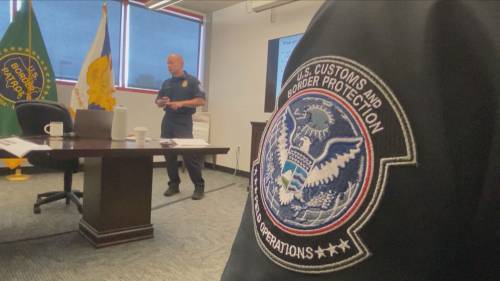Behind the imposing concrete barriers and uniformed officers lies an intricate ballet of security protocols, technological screening, and human judgment that keeps North America’s borders both secure and functional. For the first time in decades, exclusive access granted to CO24 reveals the inner workings of the Blaine border crossing—one of the busiest ports of entry connecting Washington State and British Columbia.
“Every vehicle, every traveler has a story,” explains Senior Border Services Officer Melanie Regan, who has served at Blaine for fifteen years. “Our job is to determine which stories require further investigation while ensuring legitimate travelers move through efficiently.”
The sophisticated operation at Blaine processes over 7,500 vehicles on an average day—a number that can double during holiday weekends. What many travelers don’t realize is that their screening begins long before they reach an officer’s booth. Advanced license plate readers, radiation detection equipment, and sophisticated algorithm-driven risk assessment tools have already evaluated approaching vehicles.
Inside the crossing’s command center, a technology hub resembling an air traffic control room monitors real-time data from multiple sources. Screens display wait times, traffic flow, and alerts from international databases. The Canada Border Services Agency (CBSA) has invested more than $87 million in technological upgrades at major crossings like Blaine over the past five years.
“Technology has transformed border security,” says Regional Director Thomas Wilson. “What once relied almost exclusively on officer intuition now combines human expertise with data-driven tools that can identify patterns invisible to the human eye.”
Despite technological advances, the human element remains crucial. Officers undergo rigorous training in behavioral analysis, document verification, and interview techniques. The average primary inspection lasts just 45 seconds, during which officers must make critical security determinations while maintaining traffic flow.
Secondary inspection areas—where selected travelers undergo more thorough examination—reveal the depth of scrutiny possible. Here, specialized teams with drug-detecting canines, advanced imaging technology, and forensic document examination capabilities can spend hours investigating suspicious cases.
“The challenge is balance,” explains Wilson. “We’re simultaneously a security operation, a trade facilitator, and often the first impression visitors have of Canada.”
The crossing also serves as a critical economic artery. Commercial operations process hundreds of trucks daily, facilitating over $23 billion in annual trade between Washington and British Columbia. Specialized commercial teams verify cargo manifests, conduct agricultural inspections, and ensure regulatory compliance for everything from automotive parts to perishable foods.
Environmental considerations have increasingly shaped operations at Blaine. New NEXUS lanes and enhanced processing technology have reduced idle times, cutting carbon emissions by an estimated 18% since 2018. The facility itself has undergone substantial retrofitting to improve energy efficiency.
The pandemic fundamentally altered border operations, with Blaine serving as a testing ground for new health screening protocols. Many of these innovations, including enhanced air filtration systems and contactless document processing, have been permanently incorporated into standard procedures.
“COVID-19 forced us to reimagine border security,” says Dr. Sarah Lam, health security advisor for the CBSA. “We discovered more efficient ways to maintain safety while processing travelers.”
What remains invisible to most travelers is the international intelligence collaboration happening behind the scenes. The Blaine crossing houses liaison officers from multiple agencies who coordinate with American counterparts at the adjacent U.S. facility. This partnership has disrupted numerous smuggling operations and intercepted wanted individuals attempting to cross between the countries.
As cross-border travel continues to increase post-pandemic, with world events and political tensions creating new security challenges, facilities like Blaine must continually evolve. Plans for future enhancements include expanded biometric verification systems and artificial intelligence tools to better predict traffic patterns.
For the thousands who cross this border daily, the operation remains largely invisible—exactly as designed. The true measure of success at Blaine is the seamless experience most travelers enjoy, unaware of the complex machinery working to ensure their journey remains uneventful.
As we witness the shifting landscape of international travel and security concerns, one question remains prominent: How will border crossings like Blaine balance the seemingly contradictory demands for heightened security and frictionless travel in an increasingly complex global environment?










